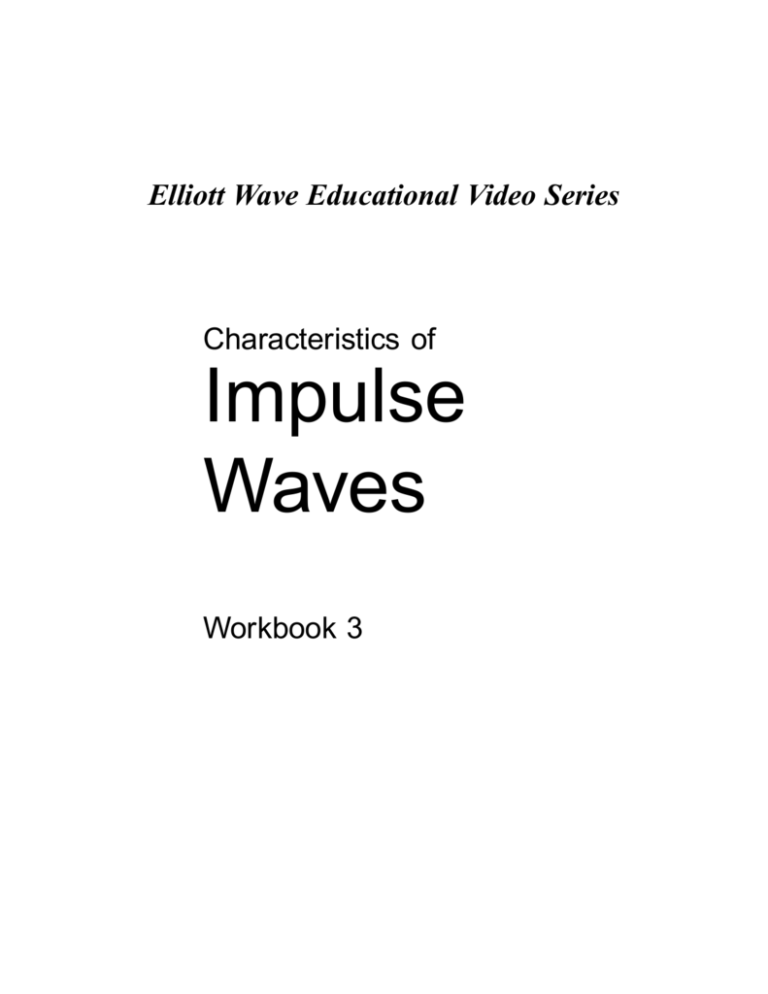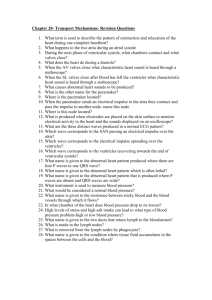
Elliott Wave Educational Video Series
Characteristics of
Impulse
Waves
Workbook 3
WORKBOOK
for the
ELLIOTT WAVE EDUCATIONAL VIDEO SERIES
WORKBOOK 3
CHARACTERISTICS OF IMPULSE WAVES
Copyright © 1990 by
Robert R. Prechter, Jr.
Printed in the United States of America
January 1990
For information, address the publishers:
Elliott Wave International
P.O. Box 1618
Gainesville, Georgia 30503
NOTICE
All charts are copyright © Robert R. Prechter, Jr. 1990 or have been previously
copyrighted by Elliott Wave International, Robert R. Prechter, Jr., or other
entities. All rights are reserved. The material in this volume may not be reprinted
or reporduced in any manner whatsoever without the written permission of the
copyright holder. Violators will be prosecuted to the fullest extent of the law.
ISBN: 0-932750-25-7
Elliott Wave Educational Video Series
10 Volume videotape set including workbooks
ISBN: 0-932750-28-1
Elliott Wave Educational Video Series
Tape 3 and Workbook 3:
Characteristics of Impulse Waves
ACKNOWLEDGEMENTS
Background charts for some of the illustrations were provided courtesy of the following sources:
Trendline (Standard & Poor’s Corp.), 25 Broadway, New York, NY 10004
Daily Graphs (William O’Neil & Co., Inc.), P.O. Box 24933, Los Angeles, CA 90024
Commodity Research Bureau, 75 Wall St., 22nd Fl., New York, NY 10005
Ned Davis Research, P.O. Box 1278, Nokomis, FL 34274
Foundation for the Study of Cycles, 3333 Michelson Dr., Irvine, CA 92715
Commodity Perspective, 30 S. Wacker Dr., Chicago, IL 60606
Securities Research Company, 208 Newbury St., Boston, MA 02116
Workshop Handout Sheet
IMPULSE WAVES — CHARACATERISTICS
EXTENSIONS
— usually appear in one of three impulse waves
— occur in one and only one of the impulse waves
— are always fives themselves, so may also contain extension
— subdivisions are of same amplitude and duration of main waves
FAILURES
— 5th wave fails to exceed 3rd wave extreme
— must contain necessary five subdivisions
— subsequent moves are sharp reversals
DIAGONAL TRIANGLES (Type 1)
— subdivide 3-3-3-3-3
— occur only in 5th or c waves
— wave 4 can and usually does overlap wave 1
— develop a wedge shape, between 2 converging lines
— proportionate to prior movement
— sometimes have sharp, last gasp break through trendline
— subsequent moves are sharp reversals
DIAGONAL TRIANGLES (Type 2)
— very rare
— subdivide 5-3-5-3-5
— occur only in A waves (substitute for A in zigzag pattern)
— wave 4 can and usually does overlap wave 1
— develop a wedge shape, between 2 converging lines
See Elliott Wave Principle pps. 25 - 34 or the Elliott Wave Workshop Workbook pps.
2.4 - 2.16 for diagrams.
Note: For your reference this workbook includes the original page numbers used during the actual presentation,
located at the bottom center of each page, in addition to being consecutively numbered in the right-hand corner.
Elliott Wave Educational Video Series — Workbook 3: Characteristics of Impulse Waves
3
1
5
4
2
Bull Market Truncation
Reprinted from
Elliott Wave Principle
Copyright © 1978
Robert R. Prechter, Jr. and A.J. Frost
(5)
3
5
1
4
(3)
2
(4)
(1)
(2)
2.48
1
Elliott Wave Educational Video Series — Workbook 3: Characteristics of Impulse Waves
Reprinted from Elliott Wave Principle
Copyright © 1978 Robert R. Prechter, Jr. and A.J. Frost
2.1
2
Elliott Wave Educational Video Series — Workbook 3: Characteristics of Impulse Waves
Reprinted from Elliott Wave Principle
Copyright © 1978 Robert R. Prechter, Jr. and A.J. Frost
2.2
3
Elliott Wave Educational Video Series — Workbook 3: Characteristics of Impulse Waves
Reprinted from Elliott Wave Principle
Copyright © 1978 Robert R. Prechter, Jr. and A.J. Frost
2.3
4
Elliott Wave Educational Video Series — Workbook 3: Characteristics of Impulse Waves
1.15
5
Elliott Wave Educational Video Series — Workbook 3: Characteristics of Impulse Waves
1.17
6
Elliott Wave Educational Video Series — Workbook 3: Characteristics of Impulse Waves
November 7, 1983
“If 1158 is broken, the next point of support is 1090,
which marks a .382 retracement of Primary 1.”
July 24, 1984 (Interim Report)
“Today’s slight new closing low in the Dow at 1086.57
generated ‘sell signals’ all over Wall Street. However, it
appears to me that, just like the May 30 low and the
June 15 low, this minor decline is actually providing
another excellent opportunity to buy. The July 11 issue
projected that ‘the next cyclic lows of importance are
due July 24-26.’ We have entered that time period, and
the wave count indicates a potential turn to the upside
within a few trading hours. Based on typical Fibonacci
relationships, I doubt that our ‘stop’ at Dow 1070 hourly
reading will be taken out. Taking in all the price action
to the present, Dow 1083 (+ or -5) is a very strong
support level.”
Note: The actual hourly low occurred two trading hours
later at Dow 1083.59.
1.27
7
Elliott Wave Educational Video Series — Workbook 3: Characteristics of Impulse Waves
1.32
8
Elliott Wave Educational Video Series — Workbook 3: Characteristics of Impulse Waves
Bear Market
Bull Market
5
3
1
4
2
2
4
1
3
5
First Wave Extension
5
2
3
1
4
4
1
3
2
Third Wave Extension
5
5
2
1
4
1
3
3
4
2
Fifth Wave Extension
5
9
2
7
5
3
1
8
4
1
6
3
6
8
5
4
7
2
Extension Not Identified
9
Reprinted from Elliott Wave Principle
Copyright © 1978 Robert R. Prechter, Jr. and A.J. Frost
2.4
9
Elliott Wave Educational Video Series — Workbook 3: Characteristics of Impulse Waves
June 10, 1980: “The chart indicates a bottom directly at hand for the first time since the peak, I expect one more
mini-wave down to slight new lows. A perfect target for 90-day T-bills would be 6.38%.”
Just six days later, this table appeared in the Wall Street Journal,
showing the June 13 low reading for the 90-day T-bills.
1.38
10
Elliott Wave Educational Video Series — Workbook 3: Characteristics of Impulse Waves
Reprinted from
Elliott Wave Principle
Copyright © 1978
Robert R. Prechter, Jr. and A.J. Frost
2.5
11
Elliott Wave Educational Video Series — Workbook 3: Characteristics of Impulse Waves
Reprinted from Elliott Wave Principle
Copyright © 1978 Robert R. Prechter, Jr. and A.J. Frost
Five waves of Primary Degree
2.6
12
Elliott Wave Educational Video Series — Workbook 3: Characteristics of Impulse Waves
13
Elliott Wave Educational Video Series — Workbook 3: Characteristics of Impulse Waves
2.7
14
Elliott Wave Educational Video Series — Workbook 3: Characteristics of Impulse Waves
3
1
5
4
2
2
Bull Market
Truncation
Bull Market
Truncation
Bear Market
Truncation
Bear
Market
Truncation
4
1
3
5
Reprinted from Elliott Wave Principle
Copyright © 1978 Robert R. Prechter, Jr. and A.J. Frost
2.8
15
Elliott Wave Educational Video Series — Workbook 3: Characteristics of Impulse Waves
2.9
16
Elliott Wave Educational Video Series — Workbook 3: Characteristics of Impulse Waves
2.10
17
Elliott Wave Educational Video Series — Workbook 3: Characteristics of Impulse Waves
(5)
5
3
1
4
(3)
2
(4)
(1)
(2)
Reprinted from
Elliott Wave Principle
Copyright © 1978
Robert R. Prechter, Jr. and A.J. Frost
(2)
(1)
(4)
2
(3)
4
1
3
5
(5)
2.11
18
Elliott Wave Educational Video Series — Workbook 3: Characteristics of Impulse Waves
2.12
19
Elliott Wave Educational Video Series — Workbook 3: Characteristics of Impulse Waves
2.13
20
Elliott Wave Educational Video Series — Workbook 3: Characteristics of Impulse Waves
2.51
21
Elliott Wave Educational Video Series — Workbook 3: Characteristics of Impulse Waves
2.14
22
Elliott Wave Educational Video Series — Workbook 3: Characteristics of Impulse Waves
Copyright © 1990 or previously by Robert R. Prechter, Jr.
2.15
23
Elliott Wave Educational Video Series — Workbook 3: Characteristics of Impulse Waves
2.16
24
Elliott Wave Educational Video Series — Workbook 3: Characteristics of Impulse Waves
1-770-536-0309 (outside the U.S.)
or 1-800-336-1618 (inside the U.S.)
25








